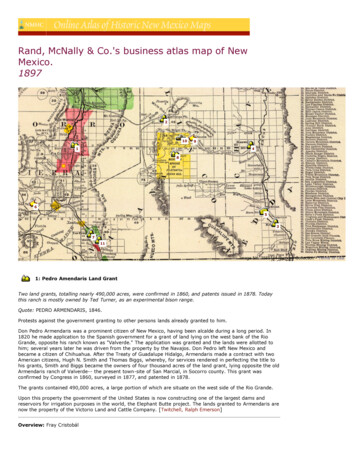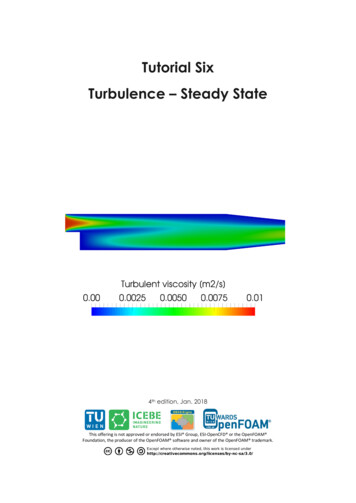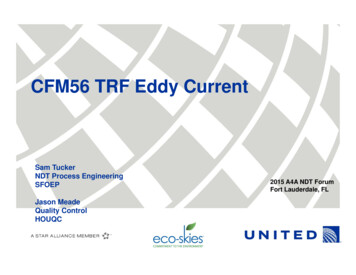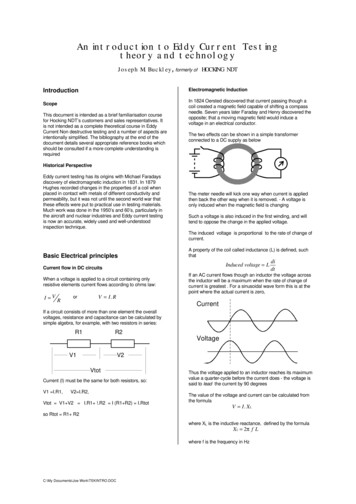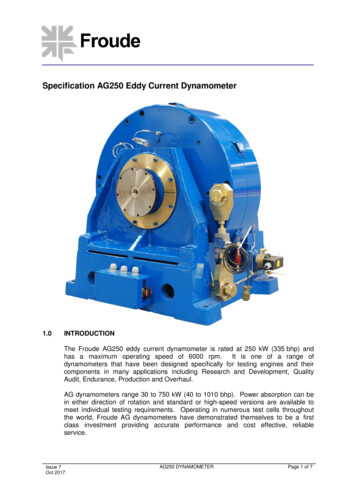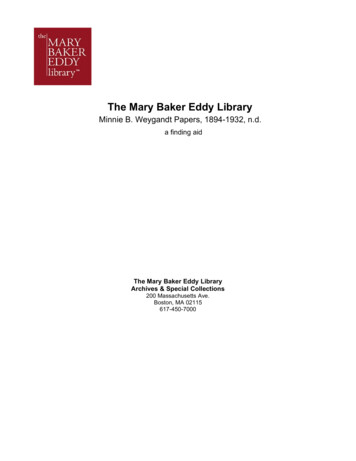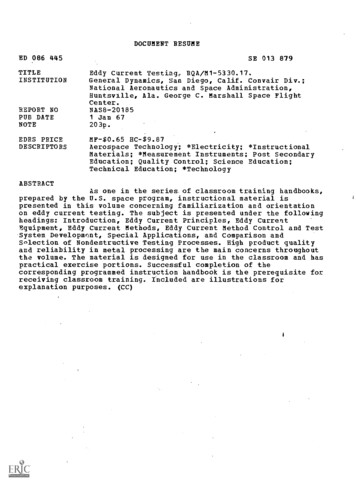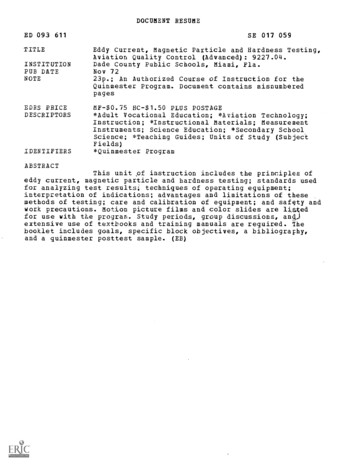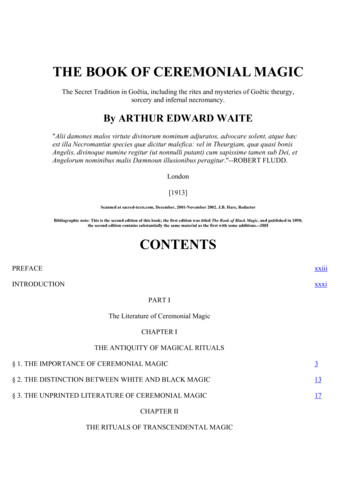
Transcription
INFERNAL User’s GuideSequence analysis using profiles of RNA sequence and secondary structure consensushttp://eddylab.org/infernalVersion 1.1.4; Dec 2020Eric Nawrocki and Sean Eddyfor the INFERNAL development teamhttps://github.com/EddyRivasLab/infernal/
Copyright (C) 2020 Howard Hughes Medical Institute.Infernal and its documentation are freely distributed under the 3-Clause BSD open source license. For acopy of the license, see al development is supported by the Intramural Research Program of the National Library of Medicineat the US National Institutes of Health, and also by the National Human Genome Research Institute of theUS National Institutes of Health under grant number R01HG009116. The content is solely theresponsibility of the authors and does not necessarily represent the official views of the National Institutesof Health.1
Contents1 IntroductionHow to avoid reading this manual . . . . . . . . .What covariance models are . . . . . . . . . . .Applications of covariance models . . . . . . . .Infernal and HMMER, CMs and profile HMMs . .What’s new in Infernal 1.1 . . . . . . . . . . . . .How to learn more about CMs and profile HMMs.66677882 InstallationQuick installation instructions . . . . . . . . . . . . . . . . . . .System requirements . . . . . . . . . . . . . . . . . . . . . . .Multithreaded parallelization for multicores is the default . . . .MPI parallelization for clusters is optional . . . . . . . . . . . .Using build directories . . . . . . . . . . . . . . . . . . . . . . .Makefile targets . . . . . . . . . . . . . . . . . . . . . . . . . . .Why is the output of ’make’ so clean? . . . . . . . . . . . . . .What gets installed by ’make install’, and where? . . . . . . . .Staged installations in a buildroot, for a packaging system . . .Workarounds for some unusual configure/compilation problems.10101011111212121213133 TutorialThe programs in Infernal . . . . . . . . . . . . . . . . . . . . . . . . . . . . . . . . . .Files used in the tutorial . . . . . . . . . . . . . . . . . . . . . . . . . . . . . . . . . .Searching a sequence database with a single covariance model . . . . . . . . . . .Step 1: build a covariance model with cmbuild . . . . . . . . . . . . . . . . . . .Step 2: calibrate the model with cmcalibrate . . . . . . . . . . . . . . . . . . . .Step 3: search a sequence database with cmsearch . . . . . . . . . . . . . . .Truncated RNA detection . . . . . . . . . . . . . . . . . . . . . . . . . . . . . .Searching a CM database with a query sequence . . . . . . . . . . . . . . . . . . .Step 1: create an CM database flatfile . . . . . . . . . . . . . . . . . . . . . . .Step 2: compress and index the flatfile with cmpress . . . . . . . . . . . . . . .Step 3: search the CM database with cmscan . . . . . . . . . . . . . . . . . . .Truncated hit and local end alignment example . . . . . . . . . . . . . . . . . .Searching the Rfam CM database with a query sequence . . . . . . . . . . . . . . .Creating multiple alignments with cmalign . . . . . . . . . . . . . . . . . . . . . . . .cmalign assumes sequences may be truncated . . . . . . . . . . . . . . . . . .Searching a sequence database for RNAs with unknown or no secondary structureForcing global CM alignment with the -g option . . . . . . . . . . . . . . . . . . . . .Specifying and annotating match positions with cmbuild –hand . . . . . . . . . . . .151515161617182424242525272830313234344 Infernal 1.1’s profile/sequence comparison pipelineFilter thresholds are dependent on database size . . . .Manually setting filter thresholds . . . . . . . . . . . . .In more detail: profile HMM filter stages . . . . . . . . .Null model. . . . . . . . . . . . . . . . . . . . . . .SSV filter. . . . . . . . . . . . . . . . . . . . . . . .Local Viterbi filter. . . . . . . . . . . . . . . . . . .Biased composition filter. . . . . . . . . . . . . . .Local Forward filter. . . . . . . . . . . . . . . . . .Glocal Forward filter. . . . . . . . . . . . . . . . . .37383940404141424243.2.
Envelope definition. . . . . . . . . . . . . . . . . . . . . . . . . . . . . .In more detail: CM stages of the pipeline . . . . . . . . . . . . . . . . . . . .HMM band definition for CM stages. . . . . . . . . . . . . . . . . . . . .HMM banded CM CYK filter. . . . . . . . . . . . . . . . . . . . . . . . .HMM banded CM Inside filter/parser. . . . . . . . . . . . . . . . . . . . .Optimal accuracy alignment. . . . . . . . . . . . . . . . . . . . . . . . .Biased composition CM score correction: the null3 model. . . . . . . . .Truncated hit detection using variants of the pipeline . . . . . . . . . . . . . .Differences between the standard pipeline and the truncated variants .Modifying how truncated hits are detected using command-line optionsHMM-only pipeline variant for models without structure . . . . . . . . . . . . .5 Profile SCFG construction: the cmbuild programTechnical description of a covariance model . . . . . . .Definition of a stochastic context free grammar . .SCFG productions allowed in CMs . . . . . . . . .From consensus structural alignment to guide treeFrom guide tree to covariance model . . . . . . . .Parameterization . . . . . . . . . . . . . . . . . . .Comparison to profile HMMs . . . . . . . . . . . .The cmbuild program, step by step . . . . . . . . . . .Alignment input file . . . . . . . . . . . . . . . . . .Parsing secondary structure annotation . . . . . .Sequence weighting . . . . . . . . . . . . . . . . .Architecture construction . . . . . . . . . . . . . .Parameterization . . . . . . . . . . . . . . . . . . .Naming the model . . . . . . . . . . . . . . . . . .Saving the model . . . . . . . . . . . . . . . . . . 5959596 Tabular output formats60Target hits tables . . . . . . . . . . . . . . . . . . . . . . . . . . . . . . . . . . . . . . . . . . . . . . 60Target hits table format 1 . . . . . . . . . . . . . . . . . . . . . . . . . . . . . . . . . . . . . . . 60Target hits table format 2 . . . . . . . . . . . . . . . . . . . . . . . . . . . . . . . . . . . . . . . 617 Some other topicsHow do I cite Infernal? . . . . . . . . . . . . . . . . . . . . . . . . . . .How do I report a bug? . . . . . . . . . . . . . . . . . . . . . . . . . .Input files . . . . . . . . . . . . . . . . . . . . . . . . . . . . . . . . . .Reading from a stdin pipe using - (dash) as a filename argument.63636364648 Manual pagescmalign - align sequences to a covariance model . . . . . . . . . .Synopsis . . . . . . . . . . . . . . . . . . . . . . . . . . . . . . .Description . . . . . . . . . . . . . . . . . . . . . . . . . . . . . .Options . . . . . . . . . . . . . . . . . . . . . . . . . . . . . . . .Options for Controlling the Alignment Algorithm . . . . . . . . . .Options for Controlling Speed and Memory Requirements . . . .Optional Output Files . . . . . . . . . . . . . . . . . . . . . . . . .Other Options . . . . . . . . . . . . . . . . . . . . . . . . . . . . .cmbuild - construct covariance model(s) from structurally annotatedSynopsis . . . . . . . . . . . . . . . . . . . . . . . . . . . . . . .Description . . . . . . . . . . . . . . . . . . . . . . . . . . . . . .6666666667676869697171713
Options . . . . . . . . . . . . . . . . . . . . . . . . . . . . . . . . . . . . . .Options Controlling Model Construction . . . . . . . . . . . . . . . . . . . .Other Model Construction Options . . . . . . . . . . . . . . . . . . . . . . .Options Controlling Relative Weights . . . . . . . . . . . . . . . . . . . . . .Options Controlling Effective Sequence Number . . . . . . . . . . . . . . .Options Controlling Filter P7 Hmm Construction . . . . . . . . . . . . . . . .Options Controlling Filter P7 Hmm Calibration . . . . . . . . . . . . . . . . .Options for Refining the Input Alignment . . . . . . . . . . . . . . . . . . . .cmcalibrate - fit exponential tails for covariance model E-value determinationSynopsis . . . . . . . . . . . . . . . . . . . . . . . . . . . . . . . . . . . . .Description . . . . . . . . . . . . . . . . . . . . . . . . . . . . . . . . . . . .Options . . . . . . . . . . . . . . . . . . . . . . . . . . . . . . . . . . . . . .Options for Predicting Required Time and Memory . . . . . . . . . . . . . .Options Controlling Exponential Tail Fits . . . . . . . . . . . . . . . . . . . .Optional Output Files . . . . . . . . . . . . . . . . . . . . . . . . . . . . . . .Other Options . . . . . . . . . . . . . . . . . . . . . . . . . . . . . . . . . . .cmconvert - convert Infernal covariance model files . . . . . . . . . . . . . . .Synopsis . . . . . . . . . . . . . . . . . . . . . . . . . . . . . . . . . . . . .Description . . . . . . . . . . . . . . . . . . . . . . . . . . . . . . . . . . . .Options . . . . . . . . . . . . . . . . . . . . . . . . . . . . . . . . . . . . . .cmemit - sample sequences from a covariance model . . . . . . . . . . . . . .Synopsis . . . . . . . . . . . . . . . . . . . . . . . . . . . . . . . . . . . . .Description . . . . . . . . . . . . . . . . . . . . . . . . . . . . . . . . . . . .Options . . . . . . . . . . . . . . . . . . . . . . . . . . . . . . . . . . . . . .Options for Truncating Emitted Sequences . . . . . . . . . . . . . . . . . . .Other Options . . . . . . . . . . . . . . . . . . . . . . . . . . . . . . . . . . .cmfetch - retrieve covariance model(s) from a file . . . . . . . . . . . . . . . . .Synopsis . . . . . . . . . . . . . . . . . . . . . . . . . . . . . . . . . . . . .Description . . . . . . . . . . . . . . . . . . . . . . . . . . . . . . . . . . . .Options . . . . . . . . . . . . . . . . . . . . . . . . . . . . . . . . . . . . . .cmpress - prepare a covariance model database for cmscan . . . . . . . . . . .Synopsis . . . . . . . . . . . . . . . . . . . . . . . . . . . . . . . . . . . . .Description . . . . . . . . . . . . . . . . . . . . . . . . . . . . . . . . . . . .Options . . . . . . . . . . . . . . . . . . . . . . . . . . . . . . . . . . . . . .cmscan - search sequence(s) against a covariance model database . . . . . . .Synopsis . . . . . . . . . . . . . . . . . . . . . . . . . . . . . . . . . . . . .Description . . . . . . . . . . . . . . . . . . . . . . . . . . . . . . . . . . . .Options . . . . . . . . . . . . . . . . . . . . . . . . . . . . . . . . . . . . . .Options for Controlling Output . . . . . . . . . . . . . . . . . . . . . . . . . .Options Controlling Reporting Thresholds . . . . . . . . . . . . . . . . . . .Options for Inclusion Thresholds . . . . . . . . . . . . . . . . . . . . . . . .Options for Model-specific Score Thresholding . . . . . . . . . . . . . . . .Options Controlling the Acceleration Pipeline . . . . . . . . . . . . . . . . .Other Options . . . . . . . . . . . . . . . . . . . . . . . . . . . . . . . . . . .cmsearch - search covariance model(s) against a sequence database . . . . .Synopsis . . . . . . . . . . . . . . . . . . . . . . . . . . . . . . . . . . . . .Description . . . . . . . . . . . . . . . . . . . . . . . . . . . . . . . . . . . .Options . . . . . . . . . . . . . . . . . . . . . . . . . . . . . . . . . . . . . .Options for Controlling Output . . . . . . . . . . . . . . . . . . . . . . . . . .Options Controlling Reporting Thresholds . . . . . . . . . . . . . . . . . . .Options for Inclusion Thresholds . . . . . . . . . . . . . . . . . . . . . . . 09090
Options for Model-specific Score Thresholding . .Options Controlling the Acceleration Pipeline . . .Other Options . . . . . . . . . . . . . . . . . . . . .cmstat - summary statistics for a covariance model fileSynopsis . . . . . . . . . . . . . . . . . . . . . . .Description . . . . . . . . . . . . . . . . . . . . . .Options . . . . . . . . . . . . . . . . . . . . . . . .919192959595959 File and output formatsInfernal CM files . . . . . . . . . . . . . . . . . . . . . . . . . . . .CM header section . . . . . . . . . . . . . . . . . . . . . . . .CM main model section . . . . . . . . . . . . . . . . . . . . .HMMER3 filter HMM format . . . . . . . . . . . . . . . . . . .HMM header section . . . . . . . . . . . . . . . . . . . . . . .HMM main model section . . . . . . . . . . . . . . . . . . . .RNA secondary structures: WUSS notation . . . . . . . . . . . . .Full (output) WUSS notation . . . . . . . . . . . . . . . . . . .Shorthand (input) WUSS notation . . . . . . . . . . . . . . .Stockholm, the recommended multiple sequence alignment formatsyntax of Stockholm markup . . . . . . . . . . . . . . . . . .semantics of Stockholm markup . . . . . . . . . . . . . . . .recognized # GF annotations . . . . . . . . . . . . . . . . . .recognized # GS annotations . . . . . . . . . . . . . . . . . .recognized # GC annotations . . . . . . . . . . . . . . . . . .recognized # GR annotations . . . . . . . . . . . . . . . . . .Sequence files: FASTA format . . . . . . . . . . . . . . . . . . . .Null model file format . . . . . . . . . . . . . . . . . . . . . . . . . .Clan input file format for cmscan . . . . . . . . . . . . . . . . . . .Dirichlet prior files . . . . . . . . . . . . . . . . . . . . . . . . . . 1011111111110 Acknowledgements.1145
1IntroductionInfernal is used to search sequence databases for homologs of structural RNA sequences, and to makesequence- and structure-based RNA sequence alignments. Infernal builds a profile from a structurallyannotated multiple sequence alignment of an RNA family with a position-specific scoring system for substitutions, insertions, and deletions. Positions in the profile that are basepaired in the h consensus secondarystructure of the alignment are modeled as dependent on one another, allowing Infernal’s scoring system toconsider the secondary structure, in addition to the primary sequence, of the family being modeled. Infernalprofiles are probabilistic models called “covariance models”, a specialized type of stochastic context-freegrammar (SCFG) (Lari and Young, 1990).Compared to other alignment and database search tools based only on sequence comparison, Infernalaims to be significantly more accurate and more able to detect remote homologs because it models sequence and structure. But modeling structure comes at a high computational cost, and the slow speed ofCM homology searches has been a serious limitation of previous versions. With version 1.1, typical homology searches are now about 100x faster, thanks to the incorporation of accelerated HMM methods from theHMMER3 software package (http://hmmer.org), making Infernal a much more practical tool for RNAsequence analysis.How to avoid reading this manualIf you’re like most people, you don’t enjoy reading documentation. You’re probably thinking: 114 pagesof documentation, you must be joking! I just want to know that the software compiles, runs, and givesapparently useful results, before I read some 114 exhausting pages of someone’s documentation. Forcynics that have seen one too many software packages that don’t work: Follow the quick installation instructions on page 10. An automated test suite is included, so you willknow immediately if something went wrong.1 Go to the tutorial section on page 15, which walks you through some examples of using Infernal onreal data.Everything else, you can come back and read later.What covariance models areCovariance models (CMs) are statistical models of structurally annotated RNA multiple sequence alignments, or even of single sequences and structures. CMs are a specific formulation of profile stochasticcontext-free grammars (profile SCFG), which were introduced independently by Yasu Sakakibara in DavidHaussler’s group (Sakakibara et al., 1994) and by Sean Eddy and Richard Durbin (Eddy and Durbin, 1994).CMs are closely related to profile hidden Markov models (profile HMMs) commonly used for protein sequence analysis, but are more complex. CMs and profile HMMs both capture position-specific informationabout how conserved each column of the alignment is, and which residues are likely. However, in a profileHMM each position of the profile is treated independently, while in a CM basepaired positions are dependenton one another. The dependency between paired positions in a CM enables the profile to model covariation at these positions, which often occurs between basepaired columns of structural RNA alignments. Formany of these basepairs, it is not the specific nucleotides that make up the pair that is conserved by evolution, but rather that the pair maintain Watson-Crick basepairing. The added signal from covariation canbe significant when using CMs for homology searches in large databases. Section 5 of this guide explainshow a CM is constructed from a structurally annotated alignment using a toy example.CMs do have important limitations though. For example, a CM can only model what is called a “wellnested” set of basepairs. Formally, in a well-nested set of basepairs there are no two basepairs between1 Nothingshould go wrong.6
positions i : j and k : l such that i k j l. CMs cannot model pseudoknots in RNA secondarystructures. Additionally, a CM only models a single consensus structure for the family it models.Applications of covariance modelsInfernal can be useful if you’re intereseted in a particular RNA family. Imagine that you’ve carefully collectedand aligned a set of homologs and have a predicted (or known) secondary structure for the family. Homologysearches with BLAST using single sequences from your set of homologs may not reveal any additionalhomologs in sequence databases. You can build a CM from your alignment and redo your search usingInfernal (this time only a single search) and you may find new homologs thanks to the added power ofthe profile-based sequence and structure scoring system of CMs. The Rfam database (Gardner et al.,2011) essentially does just this, but on a much larger scale. The Rfam curators maintain about 2000 RNAfamilies, each represented by a multiple sequence alignment (called a seed alignment) and a CM built fromthat alignment. Each Rfam release involves a search through a large EMBL-based nucleotide sequencedatabase with each of the CMs which identifies putative structural RNAs in the database. The annotationsof these RNAs, as well as the CMs and seed alignments are freely available.Automated genome annotation of structural RNAs can be performed with Infernal and a collection ofCMs from Rfam, by searching through the genome of interest with each CM and collecting informationon high-scoring hits. Previous versions of Infernal were too slow to be incorporated into many genomeannotation pipelines, but we’re hoping the improved speed of version 1.1 changes this.Another application is the automated construction and maintenance of large sequence- and structurebased multiple alignment databases. For example, the Ribosomal Database Project uses CMs of 16S smallsubunit ribosomal RNA (16S SSU rRNA) to maintain alignments of millions of 16S sequences (Cole et al.,2009). The CMs (one archaeal 16S and one bacterial 16S model) were built from training alignments ofonly a few hundred representative sequences. The manageable size of the training alignments means thatthey can be manually curated prior to building the model. Rfam is another example of this application toobecause Rfam creates and makes available multiple alignments (called full alignments) of all of the hitsfrom the database its curators believe to be real RNA homologs.Infernal can also be used to determine what types of RNAs exist in a particular sequence dataset.Suppose you’re performing a metagenomics analysis and have collected sequences from an exotic environmental sample. You can download all the CMs from Rfam and use Infernal to search through all yoursequences for high-scoring hits to the models. The types of structural RNAs identified in your sample canbe informative as to what types of organisms are in your sample, and what types of biological processesthey’re carrying out. Version 1.1 includes a new program called cmscan which is designed for just this typeof analysis.Infernal and HMMER, CMs and profile HMMsInfernal is closely related to HMMER. In fact, HMMER is used as a library within the Infernal codebase. Thisallows Infernal to use the highly optimized profile HMM dynamic programming implementations in HMMERto greatly accelerate its homology searches. Also, the design and organization of the Infernal programs (e.g.cmbuild, cmsearch, cmalign) follows that in HMMER (hmmbuild, hmmsearch, hmmalign). And there aremany functions in Infernal that are based on analogous ones in HMMER. The formatting of output is oftenvery similar between these two software packages, and the user guide’s are even organized and written ina similar (and, in some places, identical) way.This is, of course, on purpose. Since both packages are developed in the same lab, consistency simplifies the development and maintenance of the code, but we also do it to make the software (hopefully)easier to use (someone familiar with using HMMER should be able to pick up and use Infernal very easily,and vice versa). However, Infernal development tends to lag behind HMMER development as new ideasand algorithms are applied to the protein or DNA world with profile HMMs, and then later extended to CMsfor use on RNAs.7
This consistency is possible because profile HMMs and covariance models are related models withrelated applications. Profile HMMs are profiles of the conserved sequence of a protein or DNA familyand CMs are profiles of the conserved sequence and well-nested secondary structure of a structural RNAfamily. Applications of profile HMMs include annotating protein sequences in proteomes or protein sequencedatabase and creating multiple alignments of protein domain families. And similarly applications of CMsinclude annotating structural RNAs in genomes or nucleotide sequence databases and creating sequenceand structure-based multiple alignments of RNA. The crucial difference is that CMs are able to modeldependencies between a set of well-nested (non-pseudoknotted) basepaired positions in a structural RNAfamily. The statistical signal inherent in these dependencies is often significant enough to make modelingthe family with a CM a noticeably more powerful approach than modeling the family with a profile HMM.What’s new in Infernal 1.1The most important difference between version 1.1 and the previous version (1.0.2) is the improved searchspeed that results from a new filter pipeline. The pipeline is explained more in section 4. Another importantchange is the introduction of the cmscan program, for users who want to know what structural RNAs arepresent in a collection of sequences, such as a metagenomics dataset2 . Another new feature of version1.1 is better handling of truncated RNAs, for which part of one or both ends of the RNA is missing dueto a premature end of the sequence (Kolbe and Eddy, 2009). These types of fragmentary sequences arecommon in whole genome shotgun sequencing datasets. While previous versions of Infernal were proneto misalignment of these sequences, version 1.1 includes implementations of CM search and alignmentalgorithms specialized for truncated sequences (Kolbe and Eddy, 2009) in cmsearch, cmscan and cmalign.Model parameterization has changed in several minor ways. Mixture Dirichlet priors for emissions andsingle component Dirichlet priors for transitions have been reestimated using larger and more diversedatasets than the ones the previous priors were derived from (discussed in (Nawrocki and Eddy, 2007)).Also, the definition of match and insert columns, previously determined by a simple majority rule using absolute counts (columns in which 50% of columns include residues were match, all others were insert),now use weighted counts (and same 50% rule) after a sequence weighting algorithm is applied. Andinserts before the first and after the final match position of alignments are now ignored by the CM construction procedure and thus no longer contribute to parameterizing the transition probabilities of the model(specifically, the ROOT IL and ROOT IR states). These changes mean that for a given input alignment amodel built with version 1.1 may have different numbers of states and nodes, and will have (usually) slightlydifferent parameters, than a model built from the same alignment with version 1.0.2. Finally, the importantcmbuild command line options --rf and --gapthresh have been renamed to --hand and --symfrac3 .The formatting of cmsearch output has also changed. It mirrors the output format of the hmmsearchprogram from HMMER3, for examples see the tutorial section of this guide. Another change is that themost compute-intensive programs in Infernal 1.1 (cmcalibrate, cmsearch, cmscan and cmalign) supportmulticore parallelization using threads.How to learn more about CMs and profile HMMsSection 5 of this guide may be a good place to start. That section walks through an example of how aCM is constructed from a structurally annotated multiple sequence alignment. The tutorial section is alsorecommended for all users.As for other available publications: two papers published in 1994 introduced profile SCFGs in computational biology (Sakakibara et al., 1994; Eddy and Durbin, 1994), and our lab has published severalpapers (Eddy, 2002; Klein and Eddy, 2003; Nawrocki and Eddy, 2007; Nawrocki et al., 2009; Kolbe andEddy, 2009, 2011), book chapters (Eddy, 2006; ?), and a few doctoral theses (Klein, 2003; Nawrocki, 2009;2 cmscan is similar to cmsearch but is more convenient for some applications. One difference between the two programs is thatresults from cmscan are organized per-sequence instead of per-model.3 To reproduce the behavior obtained in previous versions with --gapthresh x use --symfrac 1-x .8
Kolbe, 2010) related to CMs4 . The book Biological Sequence Analysis: Probabilistic Models of Proteinsand Nucleic Acids (Durbin et al., 1998) has several chapters devoted to HMMs and CMs. Profile HMMfiltering for CMs was introduced by Weinberg and Ruzzo (Weinberg and Ruzzo, 2004a,b, 2006). There aretwo papers from our lab on HMMER3 profile HMMs that are directly related to Infernal’s accelerated filterpipeline (Eddy, 2008, 2011).Since CMs are closely related to, but more complex than, profile HMMs, readers seeking to understandCMs who are unfamiliar with profile HMMs may want to start there. Reviews of the profile HMM literaturehave been written by our lab (Eddy, 1996, 1998) and by Anders Krogh (Krogh, 1998). And to learn moreabout HMMs from the perspective of the speech recognition community, an excellent tutorial introductionhas been written by Rabiner (Rabiner, 1989). For details on how profile HMMs and probabilistic models areused in computational biology, see the pioneering 1994 paper from Krogh et al. (Krogh et al., 1994) andagain the Biological Sequence Analysis book (Durbin et al., 1998).Finally, Sean Eddy writes about HMMER, Infernal and other lab projects in his blog Cryptogenomiconhttp://cryptogenomicon.org/). How do I cite Infernal? The Infernal 1.1 paper (Infernal 1.1: 100-fold faster RNA homology searches, EPNawrocki and SR Eddy. Bioinformatics, 29:2933-2935, 2013.) is the most appropriate paper to cite. If yourewriting for an enlightened (url-friendly) journal, you may want to cite the webpage http://eddylab.org/infernal/ because it is k
Infernal is used to search sequence databases for homologs of structural RNA sequences, and to make sequence- and structure-based RNA sequence alignments. Infernal builds a profile from a structurally annotated multiple sequence alignment of an RNA family with a position-specific scoring system for substi-tutions, insertions, and deletions.
